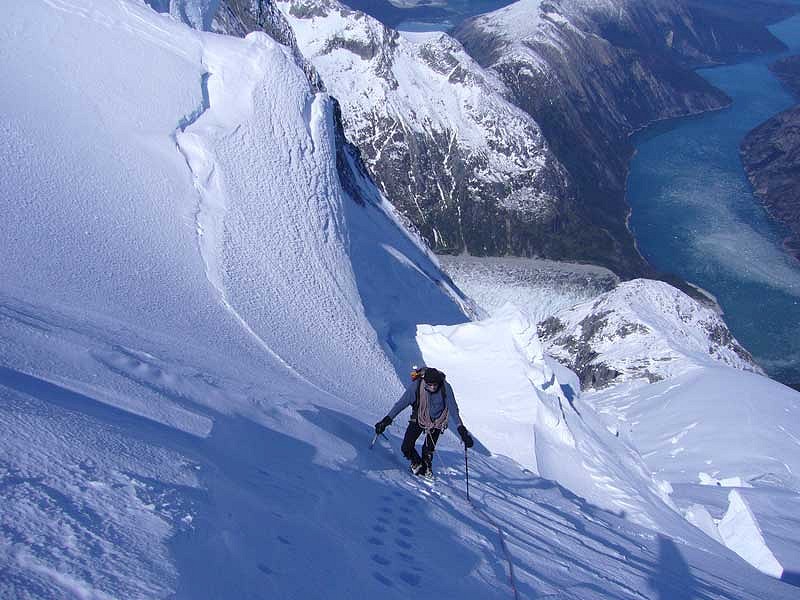
I staggered through the last of the trees and onto the beach. It had been a long day's hike. Outside of the forest a panorama opened up before me. The yacht Iorana sat neatly in the small bay of Caleta Eugenio here at the eastern end of Isla Hoste. The water was almost flat, but in the distance on the mountains of Tierra del Fuego the tops were shrouded in black cloud, the snow-line was down and out in the open water of the Beagle Channel there were white horses. It was a beautiful view and a magnificent setting and the walk into the mountains had been pleasant enough, but it was not where we wanted to be. The wind that had brought us into this place for shelter the previous morning was still blowing and the mountains we were trying to reach still some way to the west. Expeditions always have there up and downs, but sometimes they gain a pace and momentum that you feel will lead to a successful outcome. I was already trying to be philosophical about writing this one off.
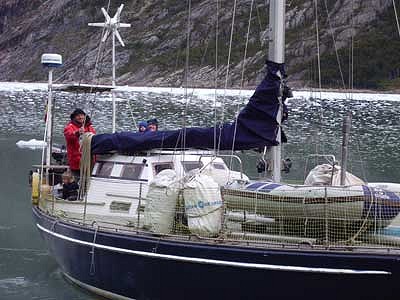
On the forth day out of Puerto Williams we woke to silence - the wind had finally dropped. However, once out in the Beagle Channel we met a wall of waves and once again were forced into an anchorage. The following day dawned wet and still. We motored west past the lonely Chilean naval post at Point Yamana and into the North West fork of the Beagle Channel. Tantalising glimpses of snow and glaciers above the northern shore offered hints of the mountains above.
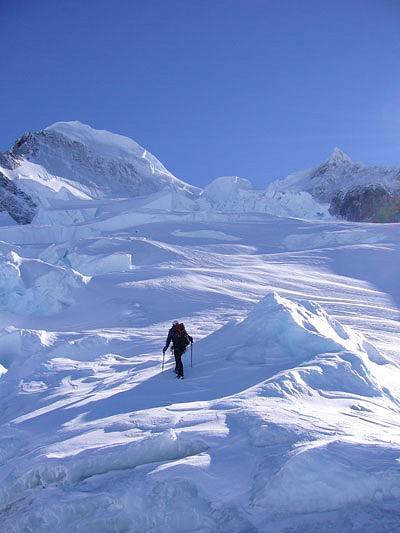
It was a relief to leave the channel later in the day, slip through a gap in a line of rocks - a submerged moraine ridge and enter the fjord itself. As we crept further along the rock walls steepened and ice began to appear in the water. The pack-ice gradually became denser towards the head of the fjord, where two huge glaciers spilled down into the water. The cloud base was low, obscuring the mountains above. Andy's map of six years earlier that had been almost lost at this very spot now came into its own. There was a 'face mixed' marked above the right-hand glacier and a suitable place nearby for a drop-off. We called it a day and went back to a beautiful anchorage in a tiny bay below a waterfall four miles back down the fjord.
A week had now passed. We still had to find an objective, climb it and make the journey back. Time was going to be tight. To add to our worries Marcel expressed his concern about dropping us off near the head of the fjord. On a previous visit he had only just escaped from the anchorage due to very dense pack-ice. If a lot of ice calved away from the glaciers there was a danger of being stranded. As land-lubbers it was not a scenario Andy and I had considered. The only positive was the air-pressure that had now climbed above 1000mb, but during the night it blew hard. A day of torrential rain followed, making a mockery of the rising barometer.
In the morning our luck began to change. The rain had stooped the cloud was lifting and it was eerily still. We slipped anchor and Marcel motored back to the drop-off. He grounded the yacht on the shore, making unloading a simple matter of passing gear down off the bow of the boat. We stood on the beach with our gear and waved our goodbyes as Iorana departed to wait at the anchorage. We had four days before the pick-up.
In a hurried frenzy we set-up base camp in the forest and left for a reconnaissance. The glacier nearby was relatively easy to cross, but the moraine on the far side did not extend above an icefall as we had hoped. We tried to go higher on the glacier and found ourselves weaving up through huge unstable seracs. It was soon obvious the dangerous terrain continued for some way above. We opted for another approach.
Back at the base camp we dumped our rucksacks and swapped boots for wellies. A gully/waterfall line up through the cliffs behind the camp offered the only viable alternative way above the icefall. It did not look pretty. Bog in the lower section of forest gave way to steep heavily wooded slopes. Progress was gained by monkeying up branches and roots. The loose boulders in the stream bed above were little better. Then a waterfall barred the way – the walls on either side coated in dripping moss. I took the plunge and nearly fell on the steepest section as a chock-stone dislodged beneath my feet, leaving me hanging from a loose block by one hand. The ground eased, but pushing through the head-high beech as the tree-line approached was a battle. Finally, I burst out into meadows, covered in what I affectionately named cabbage daisies. The sun was now shinning, swallows were darting around picking up insects floating above the flowers and the views of the fjord stupendous.
Time was getting on so I hurried to get across the meadows, but the terrain proved awkward. The knee-high daisies poked through wet snow and the slope was steep. Snow slipped from the daisy leaves when trodden on and the stems broke off in the hands as I tried to use them for purchase. Staggering progress was regularly interrupted by barely controlled bum-slides until I reached a shoulder and could look down on the glacier. The view was not encouraging. The icefall continued way up the glacier, with a further band of seracs between the glacier and the face. The approach to the face was simply not safe and the face itself was bare of snow and ice.
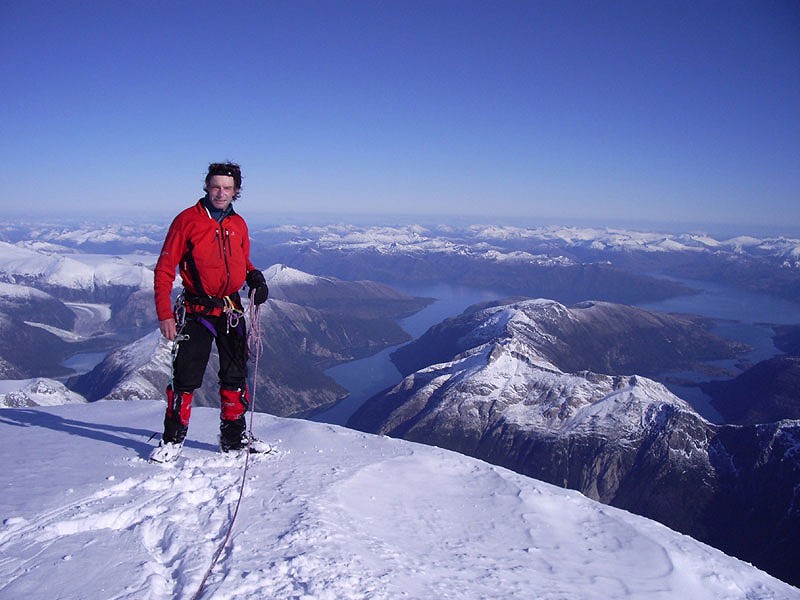
Retracing my steps I returned to break the news to Andy, who I had got way from in the gully. I met him just above the tree-line, looking ragged and dripping wet. 'You cannot be serious,' he said.'Coming up here with a rucksack on.' It was a fair point. He soon related tales of slips and small falls. His time in the gully had been even worse than mine. I informed him of my discoveries and with the day drawing to a close we set off down.
The descent of the gully was unpleasant, but mercifully quick. Soon we were back in our forest base camp discussing options. Should we try and approach the face and force a way up it, or go for a more modest objective at the head of the fjord? With time pressing, a desire for self-preservation and an urge to make the most of the good weather we opted for the latter.
The night passed clear and cold and in the morning there was frost in the forest and a skimming of ice on the fjord. The barometer remained absurdly high. After a leisurely start, we packed our rucksacks, re-crossed the glacier and headed off directly up the hillside. Stream-bed gave way to forest, cabbage daisies and then rock slabs covered in deep snow. The ground was slow-going and route finding difficult but at least we were making progress. Towards the end of the day we reached a glacier and followed it up it to a shoulder below a faint rocky ridge. We chopped out a platform and put up the tent.
The ridge above ran up to another glacier split by a band of seracs. A ramp line through the seracs led into a basin capped by further seracs below the summit. It all looked reasonable and the weather was holding. We went to sleep confident, anticipating a special day to follow.

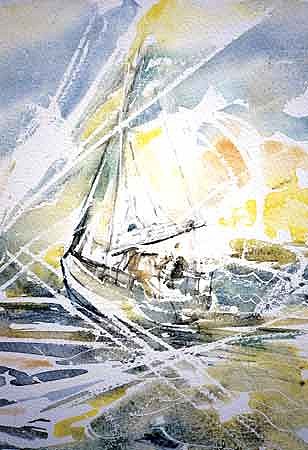
We reached the tent just before nightfall and were back at our base camp by lunch-time the following day. I called by radio for the pick-up and as we ferried bags to the shore we watched Iorana slowly advancing up the fjord through the ice. As it approached we could make out figures on deck. 'Hello stinky bum,' echoed around the fjord. Maisy was smiling, waving frantically from the back of the boat. The magical silence of the previous few days was broken. A different life beckoned.
Sometime during our incredible summit day Andy remarked 'It might not be hardest mountain I've ever climbed but it's certainly one of the best.' I had to agree. The peaks had no name, so in keeping with our own tradition (Monte Ada - Celia Bull's boat in 2001) we named them after Marcel's yacht - Monte Iorana I & II. Apparently, it means 'good day' in Polynesian. It seemed quite apt. It had been a good day.
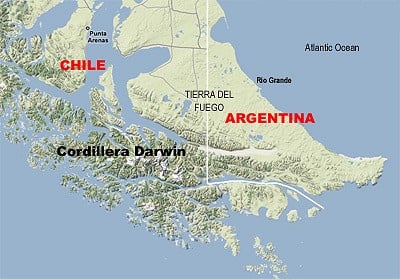
About The Author: Simon Yates
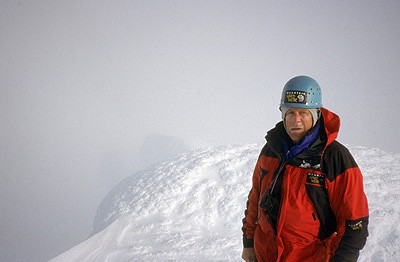
25 years later, Simon is one of the most famous and accomplished exploratory mountaineers of his time. After the harrowing events of his and Joe Simpson's first ascent of the West Face of Siula Grande in the Peruvian Andes in 1985 during which Simon was forced to take the decision to cut Joe's rope after he had fallen in a crevasse (as recounted in the bestselling book and BAFTA award-winning film 'Touching the Void') Simon carried on to climb in some of the most remote and rarely explored mountain ranges of the world. He has made eleven visits to the Pakistani Karakoram, climbing numerous peaks including first ascents of Leyla Peak (6300m) and Nemeka (6400m) in Hushe. He succeeded with a team making the first British ascents of Khan Tengri (6995m) in Kazakhstan and for a time concentrated on big wall climbing in Patagonia and Baffin Island – his most notable achievement a new route on the Central Tower of Paine in Chile. Simon has made four sailing and mountaineering trips to Chilean Tierra del Fuego resulting in the first ascents of Monte Ada (2100m) and Monte Iorana (2300m). In September 2004 Simon returned to Pakistan and made the first ascent of the South West Face of Hispar Sar (6400m), and in May 2005 climbed a new route on the West Face of Mount Alverstone (4439m) the remote Wrangell-St Elias range of mountains on the Alaskan–Yukon border.
As well as his mountaineering achievements, Simon also runs an expedition company and is a successful speaker and writer. His first book 'Against the Wall' was runner up in The Boardman Tasker Award for mountain literature in 1997 and his second book 'The Flame of Adventure' was short-listed for a prize in the prestigious Banff Mountain Book Festival in 2001.
Simon currently lives near Penrith in the Lake District and is married with 2 young children.
SIMON YATES ON TOUR
'Beyond the Void' - Simon Yates: event dates at speakersfromtheedge.com
Venue Cymru, Llandudno. 7.30 pm Monday 3 March. Box office: 01492 872000
Malvern Theatres. 7.30 pm Tuesday 4 March. Box office: 01684 892277
The Place, Telford. 7.30 pm Wednesday 12 March. Box office: 01952 382 382
Bedford Corn Exchange. 7.30 pm Thursday 13 March. Box office: 01234 269519
Reading Concert Hall. 7.30 pm Friday 14 March. Box office: 0118 960 60 60
King's Lynn Arts Centre. 7.30 pm Saturday 15 March. Box office: 01553 764864
Royal Spa Centre. 7.30 pm Sunday 16 March. Box office: 01926 334 418
Leeds City Varieties. 7.30 pm Tuesday 18 March. Box office: 08456 441 881
Playhouse, Weston-Super-Mare. 7.30 pm Wednesday 19 March. Box office: 01934 645 544
Theatre Mwldan, Cardigan. 7.30 pm Thursday 20 March. Box office: 01239 621200
The Gala, Durham. 7.30 pm Saturday 22 March. Box office: 0191 332 4041
Albert Halls, Bolton. 7.30 pm Tuesday 25 March. Box office: 01204 334400
Octagon Theatre, Yeovil. 7.30 pm Wednesday 26 March. Box office: 01935 422884
Charter Hall, Colchester. 7.30 pm Saturday 29 March. Box office: 01206 282020
Lighthouse, Poole. 7.30 pm Monday 31 March. Box office: 08700 668701
Pavilion Theatre, Worthing. 7.30 pm Tuesday 1 April. Box office: 01903 206206
Congress Theatre, Eastbourne. 7.30 pm Wednesday 2 April. Box office: 01323 412000
Dorking Halls, Dorking. 8.00 pm Thursday 3 April. Box office: 01306 881717
Guildhall, Preston. 7.30 pm Tuesday 22 April. Box office: 0845 344 2012
The Lights, Andover. 7.30 pm Wednesday 23 April. Box office 01264 368368
Theatr Brycheiniog, Brecon. 7.30 pm Friday 25 April. Box office: 01874 611622
St Albans Arena. 7.30 pm Thursday 8 May. Box office: 01727 844488
To learn more about the clients of Speakers From the Edge or to contact us about a booking then please contact Rebecca Varley at speakersfromtheedge.com

Comments